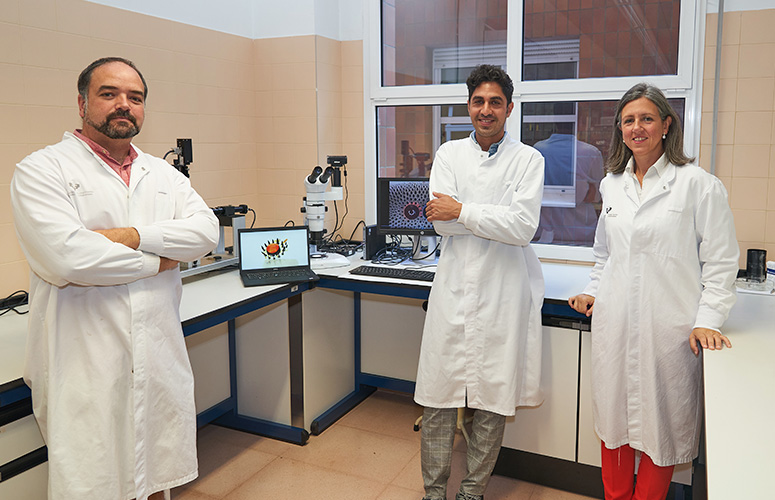A study carried out by the UPV/EHU’s Microfluidics Cluster, published by the prestigious journal Advanced Functional Materials, has presented and characterised the formation and properties of a superparamagnetic ring, which fits snugly around a drop of water due to liquid-liquid interaction, and allows the drops to be physically manipulated. The study is part of the European MAMI project, which involves multidisciplinary groups and companies from six countries.
-

Eco friendly, inexpensive system for storing high-power energy from pine biomass
-

Sediment transport restored after demolition of the Olloki dam
-

Toxic chemical pollutants detected in lichens and mosses in the Irati forest
-

Pollinator diversity in urgent need of protection to ensure ecosystems function properly
The movement of small water droplets is controlled by means of a magnet
The Microfluidics Cluster of the UPV/EHU-University of the Basque Country has created a paramagnetic ring that encapsulates water droplets under a magnetic field
- Research
First publication date: 10/08/2021

Droplet manipulation is kindling great interest in several fields, including technological applications and basic studies in dynamic systems. The Lab-on-a-chip and microfluidics community is particularly interested in the precise manipulation of small volumes of fluids, droplet microfluidics. A piece of research conducted by the UPV/EHU's Microfluidics Cluster has found that a superparamagnetic ring forms spontaneously around a water droplet when an oil-based ferrofluid is in contact with the droplet under the influence of a magnetic field and varies according to the strength of the magnetic field applied.
The ring consists of an oil-based ferrofluid, a stable suspension of ferromagnetic particles in an oil phase. It appears spontaneously due to the oil-water interfacial interaction under the influence of a magnetic field. "The ferrofluid-water interaction resembles a cupcake, with the surrounding ring only at the base of the droplet," explained the Ikerbasque professor Lourdes Basabe, who leads the cluster. The ring is analogous to a soft matter ring magnet, "which stabilises the droplets on a surface, and prevents them from mixing. And these water droplets can move with precision by displacing the external magnetic field," she added.
UPV/EHU lecturer Fernando Benito-López, the cluster’s lead researcher, explained that "under a magnetic field the water droplets can be encapsulated in the ferrofluid, and be moved remotely by moving a magnet, thanks to the magnetic properties of the ferrofluid. Even when two or more cupcakes are mechanically joined together, the water droplets do not mix, because their ferrofluid rings fuse together to form an isolating physical barrier. Moreover, as it is paramagnetic, if the magnet is removed, if the magnetic field is removed, the effect disappears, in other words, it is a switchable structure, and these drops can be mixed by switching off the magnetic field. Likewise, this assembly could be formed on top of a substrate or, like a hanging cupcake, on the underside of a substrate". These are millimetre-sized droplets, which contain volumes on a microlitre scale, and "so multiple possibilities are opened up for handling such small volumes," he added.
A new, advantageous approach to open-surface droplet microfluidics
Both researchers assert that this finding "makes possible the robust, controllable and programmable manipulation of the enclosed water droplets. This work opens the door to new applications in inverted or open-surface microfluidics, lays the foundations for new studies into interactions between two immiscible liquids and could lead to new studies, a new piece of knowledge relating to liquid-liquid interaction. They also reveal that the use of this ring to manipulate a hanging droplet is the first example of the magnetic manipulation of droplets on an inverted surface, thus opening up the way to new applications.
This is basic research that may have currently unknown applications, but for the time being they list a number of possibilities, such as "the development of sensing devices for liquids, chemical reactions on the microscale with small amounts of reagents, analysis of individual cells, detection of substances in aerosols, etc.".
Now, "we want to find out how small these droplets can be. We would like to explore the development of new microfluidic technologies, in other words, the manipulation of very small volumes, or develop the systems generated through this project to produce fluid analysis devices based on magnetic properties, or at least exploit those properties in some way,” they said.
The researchers are grateful for the European funding obtained thanks to the European MAMI project, "an international training network for PhD students, formed by a consortium of research groups and multidisciplinary companies from six countries to develop new technologies around the use of magnetic materials, which has allowed us to recruit people who are very highly motivated". They are also delighted that this great discovery has been made "in a young research group, which shows that top-level research can be carried out at the UPV/EHU".
Bibliographic reference
- Tunable Superparamagnetic Ring (tSPRing) for Droplet Manipulation
- Advanced Functional Materials
- DOI: 10.1002/adfm.202100178

